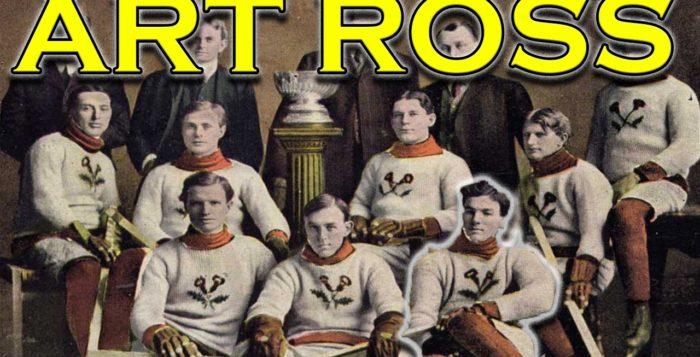This Day in Hockey History – August 5, 1964 – Loss of Boss Ross
Art Ross lived for nearly 79 years and spent 49 of them working in professional hockey. During that time, he filled almost every position, from player to referee to coach to general manager to vice president. By and large, his playing career was centered around Montreal while his post-playing career focused on developing the Boston Bruins from their inception. Born January 13, 1886, Ross was the 12th of 13 children, who grew up first near Sudbury, Ontario and then in Westmount of Montreal, Quebec. He spent the final years of his life at a nursing home in Medford, Massachusetts, where he died on August 5, 1964.
After playing high school and junior hockey at Westmount (with Lester and Frank Patrick), Ross started his professional hockey career in 1905 with the Brandon Wheat Cities of the Manitoba Hockey League. However, the majority of his 13-year playing career was spent with the Montreal Wanderers. His first Stanley Cup came from defeating them in 1907, but the next season, he won the Cup with the Wanderers. With the Wanderers, Ross played his only three NHL games and retired after their rink burned down (leading to the team folding). Ross revolutionized the defense position by skating the puck up the ice (instead of just passing to a forward), thus becoming the top rushing defenseman of his era. For the Hockey Hall of Fame, in 1945 Ross was one of the very first group inducted. Thirty years later, he was also inducted into the Canadian Sports Hall of Fame.
The career behind the bench began while Ross still played, like with the Wanderers during their only NHL season. After his retirement, he refereed a bit and then coached the Hamilton Tigers for the 1922-23 season. There, he began implementing off-ice work to increase physical fitness.
Ross’s true calling came in 1924, when Charles Adams was granted an NHL franchise in Boston. Adams hired Ross to be the first coach and general manager, and Ross chose the nickname Bruins based on the yellow and brown uniform colors. For the next 30 years, Ross managed the Bruins, coaching them for 17 seasons. After a slow start, the Bruins began picking up steam after Boston Garden opened in November 1928 and went on to win their first Stanley Cup that spring. Under Ross’s coaching, the Bruins won another championship in 1939, and two years later, they won again while he managed the team. With Ross’s guidance, the Bruins topped the league standings ten times.
It took three tries before Ross could retire completely from coaching and focus on managing. In 1934, he hired former teammate Frank Patrick but had to replace him when his drinking became a problem. Then, in 1939, he hired Cooney Weiland, but Ross again stepped in to coach in 1941. Finally, Ross stepped back for the last time in 1945. The coaching saga continued until 1950, when he convinced Lynn Patrick to take the job.
Beyond the Bruins, Ross left quite the legacy in hockey innovations and was called the “man who never ran out of ideas.” In 1927, his B-shaped goal nets (that better caught the puck) was adopted by the NHL and used until 1984. He also designed the synthetic rubber, bevel-edged puck (which reduced bouncing). In 1931, Ross pulled goalie Tiny Thompson to add a sixth attacker, marking the first instance of this kind of substitution. With Frank Boucher, he added the red line to help speed up the game. Finally, in 1947, he and his two sons donated a trophy which ever since has been presented annually to the NHL’s top scorer as the Art Ross Trophy.
Ross finally retired completely in 1954. He had been laying the groundwork since at least Patrick’s hiring in 1950 since Patrick would succeed him as general manager. The team was sold in 1951, which led to Ross being bought out of his shares the following September. His five-year contract was scheduled to end May 1, 1953, and his wife Muriel died just ten days later. Trying to keep busy, Ross signed a one-year contract as GM and then was voted back in as vice president. At the Bruins’ annual break-up dinner, on April 1, 1954, Ross announced his retirement with the promise to serve as advisor for another half year. His formal retirement came on September 30. For his work with the U.S.-based Bruins, in 1984 he received the Lester Patrick Trophy for service to hockey in the United States.
By the time he left the Bruins, his vision was so poor, the glare from ice caused severe headaches. His health continued to decline so that he moved into the nursing home in 1962. Although he had had a feud with Conn Smythe pretty much since the Bruins’ beginnings, Smythe sent a simple but touching telegram upon Ross’s death. “Sorry to hear the old Bruin warrior has gone along. Give my deepest sympathy to his family.” Funerals were held in Boston and Montreal, where Ross was buried at Mount Royal Cemetery by Muriel.
Additional Sources:
- Eric Zweig, Art Ross: The Hockey Legend Who Built the Bruins(Dundurn, 2015).
- https://www.hockey-reference.com/coaches/rossar01c.html
- https://www.hhof.com/LegendsOfHockey/jsp/LegendsMember.jsp?mem=p194510&type=Player&page=bio&list=ByName
- Arthur Siegel, “Ross Dies . . . Hockey Genius,” Boston Globe, 6 Aug. 1964, pp. 1 and 39.
- “Art Ross Dies at 79,” Montreal Gazette, 6 Aug. 1964, p. 13.















[…] https://thepinkpuck.com/2019/08/05/this-day-in-hockey-history-august-5-1964-loss-of-boss-ross/ […]